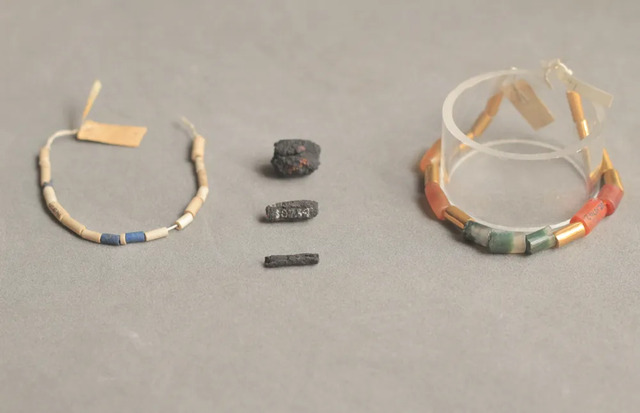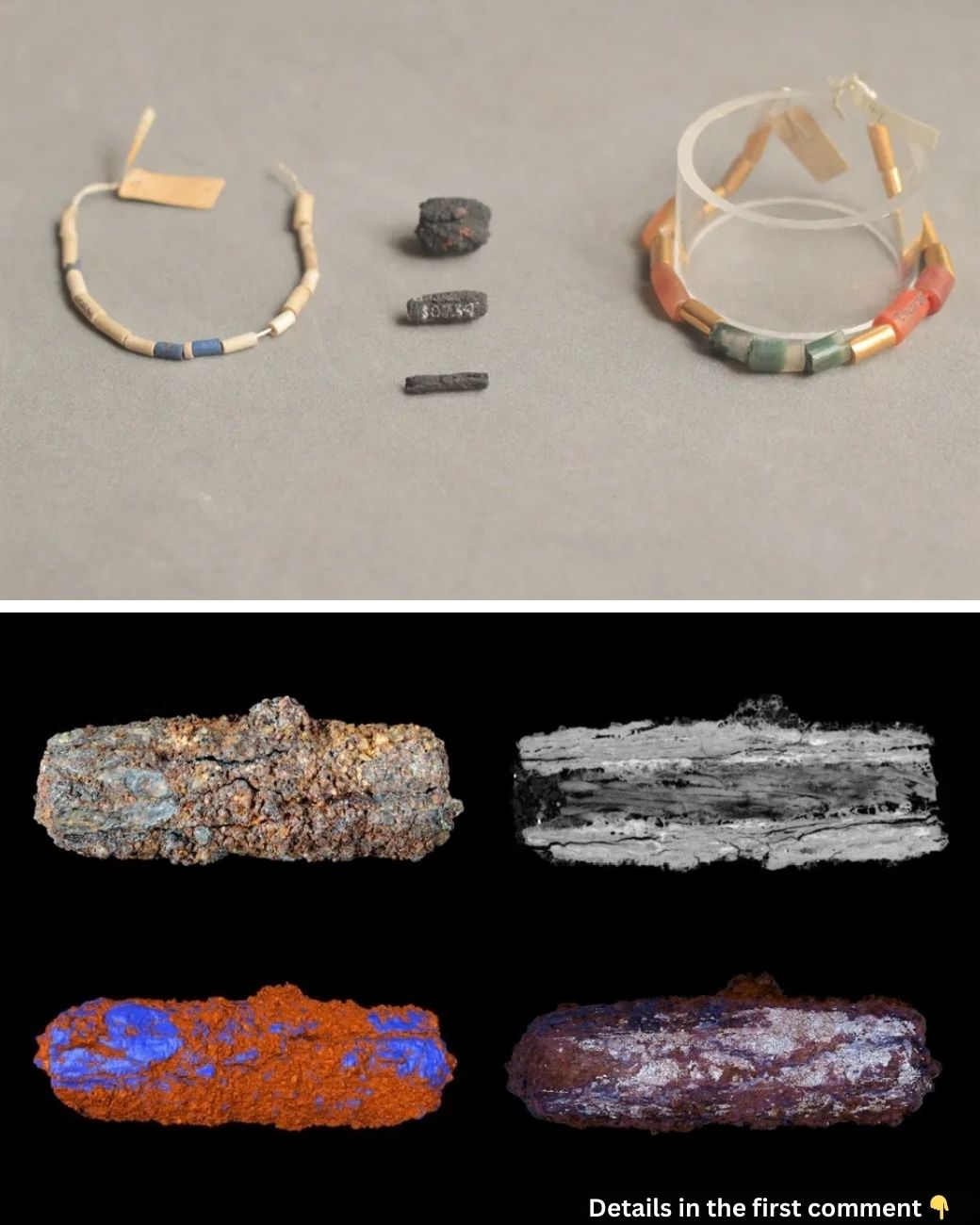For centuries, Egypt has been celebrated for its remarkable contributions to human civilization, from monumental architecture to incredible advances in science, medicine, and metallurgy. However, a lesser-known aspect of ancient Egyptian craftsmanship has recently intrigued researchers: the use of meteorite-derived iron in their jewelry. The discovery of iron beads in a 5,000-year-old tomb near Cairo has revealed that ancient Egyptians crafted some of their most exquisite ornaments from materials that fell from the sky. This finding not only sheds light on the skills of ancient artisans but also on the spiritual and cultural significance of meteoritic iron in early Egypt.
The Gerzeh Beads: The First Iron Artifacts in Ancient Egypt
The story of these extraordinary beads begins in 1911, when nine tube-shaped iron beads were uncovered in a tomb at the Gerzeh cemetery, located south of Cairo. These beads, dating to around 3200 BCE, are believed to be the first known examples of iron use in Egypt, long before the Iron Age officially began in the region around 850 BCE. The tomb, thought to belong to a teenage boy, contained not just iron beads but also gold and precious gemstones, indicating the wealth and status of the individual buried there.

While the discovery of gold and gemstones in such a burial was not unusual, the iron beads immediately raised questions. At the time, iron was not yet being smelted in Egypt. The presence of iron, especially in such a refined and carefully crafted form, was an anomaly that puzzled researchers. Even more intriguing was the material’s unusual properties: it contained high levels of nickel, a key indicator of meteoritic origin. This revelation opened up an entirely new chapter in the history of ancient Egyptian metallurgy, suggesting that Egyptians may have been working with meteorite iron centuries before the advent of smelting.
Video
Watch the video to discover how ancient Egyptian relics were made of iron from space – an incredible revelation!
Meteoric Iron: Celestial Metal and Its Cultural Significance
Meteoric iron has a fascinating history, as it is the only form of native iron found on Earth before humans developed the ability to smelt and refine iron from terrestrial sources. This iron, which originates from fallen meteorites, is a rare and precious material, often considered to have cosmic significance. To ancient people, iron from the heavens was not merely a metal—it was imbued with spiritual and religious meaning. The Egyptians, known for their reverence of the cosmos and celestial bodies, may have viewed meteoritic iron as a divine gift from the gods, imbued with supernatural power.

The use of meteoritic iron in the Gerzeh beads suggests that the ancient Egyptians did not merely see the metal as a practical material but as something extraordinary, capable of connecting them to the heavens. Iron, a material that was both rare and mysterious, likely had symbolic value and may have been reserved for special rituals or ceremonial purposes. Its inclusion in a tomb, particularly in a burial of a young person, suggests that the metal was perceived as having magical properties, perhaps meant to protect or guide the deceased in the afterlife.
The craftsmanship involved in working with meteoritic iron also demonstrates an advanced level of technological skill. Unlike gold or copper, iron is not easily shaped and requires heating and hammering at high temperatures to work it into useful forms. The fact that ancient Egyptians were able to fashion such intricate beads from this difficult material speaks to their ingenuity and understanding of metallurgy long before the development of iron smelting.
Scientific Analysis: Confirming the Meteorite Origins of the Beads
For many years, the cosmic origins of the iron beads were merely a theory. Early tests revealed high concentrations of nickel, but without conclusive evidence, some researchers remained skeptical. It wasn’t until recent decades, with the advent of more advanced scientific techniques, that the true origins of the beads could be confirmed.
Using X-ray CT scanning and electron microscopes, scientists were able to analyze the chemical composition of the beads in detail. The results were definitive. Not only did the beads contain high levels of nickel, but they also showed traces of cobalt, phosphorus, and germanium—elements found in meteorites but not typically present in terrestrial iron. Additionally, the beads displayed a Widmanstätten pattern, a distinctive crystal structure found only in meteorites that cooled very slowly in the vastness of space. These findings provided irrefutable evidence that the iron in the beads came from a meteorite that had fallen to Earth millennia ago.
Furthermore, the beads were found to have been cold-worked, meaning they were hammered into shape without the use of heat. This is a significant detail, as it suggests that ancient Egyptian artisans were able to manipulate meteoritic iron with precision and skill, even though they did not have the ability to smelt iron. This technique of cold-working is consistent with the ancient Egyptian tradition of working with materials in their natural state, such as stone and metals.
The Role of Meteoric Iron in Other Ancient Cultures
The use of meteoritic iron is not unique to ancient Egypt. Other cultures around the world have also used meteorites to create tools, weapons, and jewelry. For instance, in Europe, some early Bronze Age artifacts were crafted from meteorite iron, while in the Americas, the Aztecs used iron from meteorites to create ceremonial items. Similarly, the Chinga meteorite, which fell to Earth thousands of years ago, was used by cultures in Siberia and Mongolia to create sculptures and other ritual objects.
These discoveries suggest that the use of meteoritic iron may have been more widespread than previously thought, and that ancient cultures shared an understanding of the material’s rarity and value. In many cases, the metal was reserved for sacred or royal purposes, further emphasizing its cultural and spiritual significance.
The Future of Meteoric Artifact Research
The discovery of meteoritic iron in the Gerzeh beads is just the beginning of a larger exploration into the use of this rare material in ancient societies. Ongoing research and advancements in technology may reveal even more artifacts made from meteorites, providing further insight into how ancient cultures interacted with the cosmos.
As scientists continue to examine the origins of meteoritic iron artifacts, they will also be able to learn more about the ways in which ancient societies understood their place in the universe. The study of meteoritic iron could reveal new information about trade routes, cultural exchange, and the religious and spiritual beliefs that shaped ancient civilizations.
Conclusion: The Ancient Link Between Earth and the Cosmos
The discovery of meteoritic iron in the Gerzeh beads is a testament to the ingenuity and cultural depth of ancient Egyptian society. These celestial materials, once thought to be rare curiosities, now serve as a reminder of the complex relationship between ancient peoples and the cosmos. As we continue to uncover more about these ancient artifacts, we gain a deeper understanding of the spiritual and technological advances that shaped early civilizations.
The Gerzeh beads, made from iron that fell from the sky, challenge our assumptions about ancient metallurgy, reminding us that the past is full of surprising connections—both earthly and cosmic. Through these discoveries, we not only learn about the materials that ancient people worked with but also about their profound connection to the stars above.
Video
Watch the video on ancient jewelry and its connection to vanished civilizations – it’s a fascinating journey through history!



